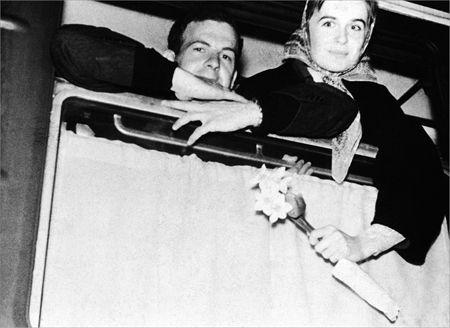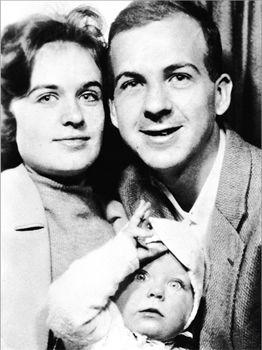Kennedy's Last Days: The Assassination That Defined a Generation (12 page)
Read Kennedy's Last Days: The Assassination That Defined a Generation Online
Authors: Bill O'Reilly

T
HE FIRST LADY GLIDES ALONE
down a hallway, walking straight toward the television cameras. Her outfit and lipstick are a striking red, but the camera will broadcast only in black and white, so this detail is lost on the 46 million Americans tuning in to watch her televised tour of the White House. This is Jackie’s moment in the national spotlight, a chance to show off her ongoing effort to restore the historic building.
She begins by narrating a brief history of the White House. Viewers hear her voice as images of historical drawings and photographs fill the screen. “Piece by piece,” she says, “the interior of the president’s house was put back together.”
The first lady once again steps before the camera to take viewers on a walk around her new home, now followed by the show’s host, Charles Collingwood of CBS. Jackie’s personal touches are everywhere, from the new draperies, whose designs she sketched herself, to the new guidebook she authorized to raise funds for the restoration. She has scoured White House storage rooms and the National Gallery of Art, turning up assorted treasures such as paintings by Paul Cézanne, Teddy Roosevelt’s drinking mugs, and James Monroe’s gold French flatware. President Kennedy’s new desk was another of Jackie’s finds. The
Resolute
desk, as it is known, was carved from the timbers of an ill-fated British vessel and was a gift from Queen Victoria to President Rutherford B. Hayes in 1880. Jackie found it in the White House broadcast room, buried beneath a pile of electronics. She promptly had it relocated to the Oval Office.

The first lady escorts the country through the newly refurbished White House. She won an Emmy Award for this televised tour. Here she is showing the State Dining Room.
[© Associated Press]
“Thank you, Mr. President,” concludes reporter Charles Collingwood. “And thank you, Mrs. Kennedy, for showing us this wonderful house in which you live, and all of the wonderful things you’re bringing to it.”
John Kennedy has joined his wife on camera for the last few minutes of the broadcast special, explaining the importance of Jackie’s ongoing efforts and what the White House means as a symbol of America.
Jackie’s White House tour is one of the most watched shows in the history of television. In fact, it earns the first lady a special Emmy Award. America is now smitten. Jacqueline Kennedy is a superstar.
CHAPTER TEN
EARLY 1962
Minsk
I
N
M
INSK, THE
O
SWALDS
’
DAUGHTER IS BORN.
Lee Harvey Oswald is ready to return home. The plan is for him, Marina, and baby June Lee to take the train to the American embassy in Moscow to pick up their travel documents. The Oswalds arrive in Moscow on May 24, 1962.
On June 1, they board a train from Moscow to the Netherlands. Lee Oswald carries a promissory note from the U.S. embassy for $435.71 to help start his life in America. They board the SS
Maasdam
, bound for America, and stay belowdecks most of the journey. Oswald is ashamed of Marina’s cheap dresses and doesn’t want her to be seen in public. He passes the time in their small cabin writing about his growing disillusionment with governmental power.
The
Maasdam
docks in Hoboken, New Jersey, on June 13, 1962. The Oswalds pass through customs without incident and take a small room at a New York City Times Square hotel.

Lee Harvey and Marina Oswald leaving Minsk, bound for the United States.
[© Corbis]
Thanks to a loan from his brother, Robert, Lee Harvey Oswald and his family fly to Dallas. The city is simmering with a rage that mirrors Oswald’s ongoing personal unhappiness in many ways. The South swung in President Kennedy’s favor during the election, but there are pockets of militant anger; people grumble about Kennedy being the first Roman Catholic president and his desire to bring about racial equality.
This is the environment into which the Oswald family arrives. They land at a Dallas-area airport called Love Field, where the president and first lady will touch down aboard
Air Force One
in 17 short months. Lee’s brother takes them to his home in nearby Fort Worth.

Marina and Lee Harvey Oswald with their daughter, June Lee, in 1962.
[© Corbis]
Oswald is unhappy that his return to the United States has not attracted widespread media attention—or any media attention at all, for that matter. He thinks that he should have been noticed. But even as he fumes that the press is nowhere in sight, he is being watched—but secretly.

Lee Harvey Oswald holding baby June.
[© Corbis]
CHAPTER ELEVEN
AUGUST 16, 1962
Fort Worth, Texas
I
T IS BRUTALLY HOT IN
F
ORT
W
ORTH.
FBI special agents John Fain and Arnold J. Brown have been waiting all day to see Lee Harvey Oswald. They sit in an unmarked car just down the street from Oswald’s newly rented apartment. Fain and Brown work for J. Edgar Hoover, the head of the FBI. Hoover’s intense preoccupation is finding and arresting anyone who sympathizes with Communists. He seems to suspect almost everybody and has created an atmosphere of suspicion and fear in thousands of innocent people.
The Oswald case is nothing new to Special Agent Fain. Back when Oswald first defected to the Soviet Union, Fain was assigned a minor investigation of Oswald’s mother because she had mailed $25 to her son in the Soviet Union. The FBI was following even the smallest leads to find Communist sympathizers.
John Fain had also spoken face-to-face with Oswald just seven weeks earlier, on June 26. Oswald’s case has been designated an “internal security” investigation, based on the concern that his defection might make him a threat to national security. Fain’s job is to find out whether the Russians trained Oswald to perform a job against the United States. Something about the first interview, which lasted two hours, didn’t sit well with Fain. One question that Fain asked and Oswald never answered in a completely truthful manner was whether the Russians demanded anything in return for letting him come back to America. A second question interests Fain: Why did Oswald go to the Soviet Union in the first place? Oswald didn’t answer that one either. He danced around it, talking about “his own personal reasons,” that “it was something that I did.” Fain didn’t like Oswald’s attitude, thinking him proud and rude.

J. Edgar Hoover, director of the Federal Bureau of Investigation of the United States.
[LOC, DIG-ppmscc-03262]
John Fain needs these questions answered. He’s a very thorough man and takes it upon himself to interview Lee Harvey Oswald one more time.
At 5:30
P.M.
, the two agents see Oswald walking down the street. Fain drives up beside him. “Hi, Lee. How are you?” he says out the car window. “Would you mind talking with us for just a few minutes?”
The three men talk for a little over an hour. Oswald is friendlier than before, less defensive. He explains that he’s been in touch with the Soviet embassy, but only because it is required for Soviet citizens such as Marina to inform the embassy of their location on a regular basis. When pressed about whether this involved discussions with Soviet intelligence officials, Oswald doesn’t answer directly, but wonders aloud why anyone would want to discuss spying with a guy like him. “He didn’t feel like he was of any importance” to the Russians, Fain will later testify.

Marina and Lee Harvey Oswald with their daughter, June Lee, in 1962.
[© Corbis]
At 6:45
P.M.
, Oswald is released from the car and goes inside his home.
